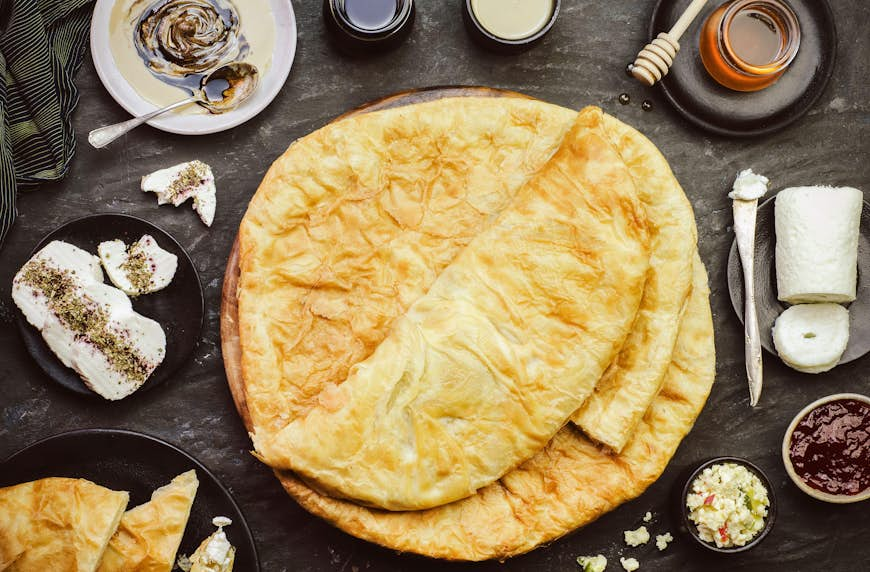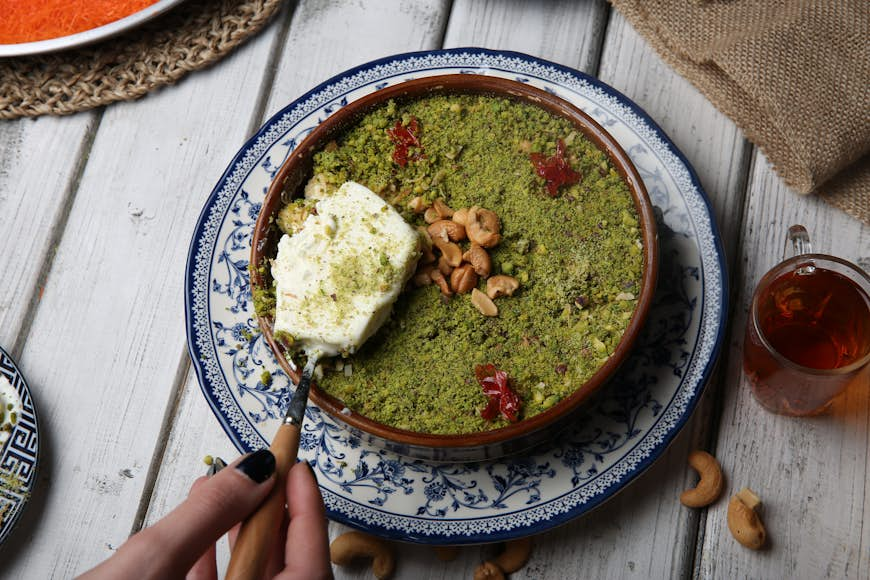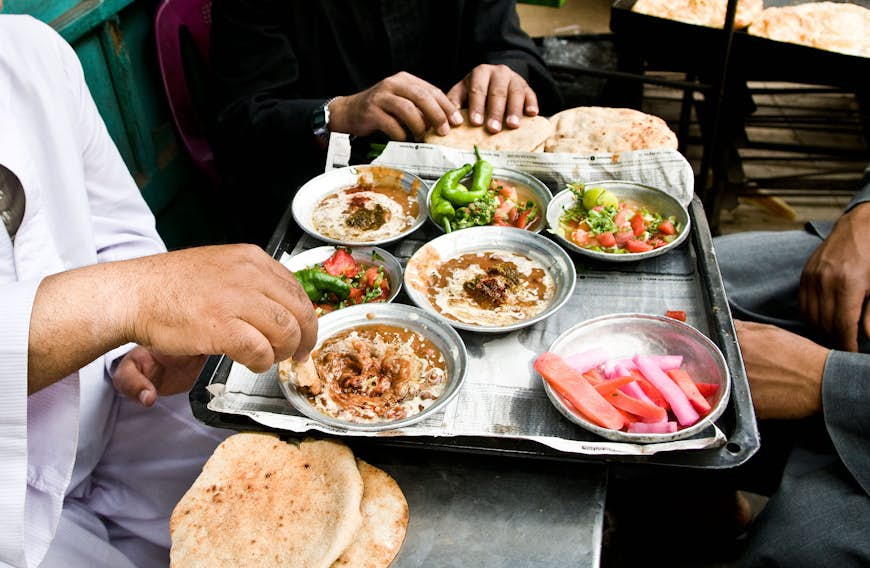Famous for its rich and diverse ingredients, Egyptian food is distinctive within the Middle East, and history and geography have played roles in its development. Few cuisines present the fusion of Africa and the Middle East better.
Meals in Egypt typically center on stews and vegetables, but Egyptians will happily wait in line at the best street food stalls that dish out kushari (a mix of noodles, rice, black lentils, fried onions and tomato sauce) and ta’amiyya (Egyptian falafel that’s made with fava beans). Fava beans are served stewed for breakfast, lunch or dinner.
Egyptians love lamb kebabs, grilled chicken, pigeon and kofta (spiced ground meat patties grilled on a skewer), while fish comes from the Mediterranean, the Red Sea, Lake Nasser and the Nile. Other specialties include the love-it-or-hate-it molokhiyya (garlicky, bitter soup made from jute mallow leaves), hamam (pigeon) and mahshi (stuffed vegetables).
Egyptians have a serious sweet tooth, and no meal is complete without dessert. Mahallabiye (milk custard with pine nuts and almonds) and ruz bi laban (rice pudding) are the most popular. Here’s what to eat and drink in Egypt.
Eat fuul medames, Egypt’s national dish
Travelers might think that no visit to Egypt is complete without visiting the Pyramids of Giza, but most Egyptians would say that no visit is complete without enjoying a plate of fuul medames, Egypt’s national dish. Fuul medames is simple, nutritious and filling. Fava beans are stewed slowly with olive oil, cumin, and a host of other spices and ingredients. Parsley, chili, lemon juice and garlic are added at the cook’s discretion.
Whether in sandwiches or scooped up with a morsel of bread, fuul medames is often eaten for breakfast or dinner. People have their own preferred additions to the dish – some add tahini, others boiled eggs. The ways of eating fuul are endless.
Where to try it: One of the best culinary experiences in Cairo is joining the locals in one of the famous fuul places, Mahrous.
Fuel up with crunchy ta’amiyya sandwiches
Ta’amiyya is a deep-fried patty of ground fava beans, parsley, coriander leaves and spices. Elsewhere in the Middle East – and around the world – falafel is made from chickpeas rather than fava beans, and without all the greens. The main difference between the two versions is that the Egyptian ta’amiyya is fluffier. A typical sandwich will include a crunchy patty surrounded by mixed salad and tahini.
Where to try it: Try ta’amiyya at Tabali Bistro in western Cairo. The atmosphere is cozy, the service is excellent, and the menu includes a wide variety of traditional dishes if you’re still hungry.
Sample Egypt’s delicious street food
Kebda iskandarani sandwiches are great quick meals when you are running around any Egyptian city because you are never far from a kebda cart. Combining finely chopped beef liver with cumin, chili, cardamom, garlic, green peppers and a squeeze of lemon, this thick-filled bread roll is cheap and hearty.
Another popular street food is kushari, a brilliant vegetarian dish. Kushari carts can be seen in crowded Egyptian streets, and you can find simple kushari restaurants almost everywhere – they are popular fast-food options.
Where to try it: For a sit-down meal of kebda instead of eating on the go, try Yokal, which offers street-food-style sandwiches in a nice atmosphere. Abu Tarek is a kushari institution in Egypt.

Devour fiteer filled with a variety of ingredients
For Egyptians, the word fiteer, a soft, flaky pastry made from paper-thin dough, recalls the excitement of vacations and feasts with family. Traditionally prepared in ovens in countryside houses, fiteer naturally leads to group gatherings as each person cuts a piece and dips it in salty feta cheese or molasses.
Served with various fillings, fiteer can be prepared savory or sweet, but cheese, sausage, ground beef, pastrami and olives are common savory ingredients. On a sweet fiteer, you can order jam, honey, custard, raisins or nuts, plus powdered sugar sprinkled on top.
Where to try it: In Cairo, Samiha makes some of the best fiteer, which is generously filled with fresh ingredients.
Treat yourself to kebab and kofta
Egypt has two hugely popular styles of grilled meat. Kebab is flame-grilled chunks of lamb, and kofta is well-seasoned ground lamb or beef mixed with parsley, onion and garlic that’s shaped on a skewer and grilled. Both are typically eaten with tahini, mixed salad, pickles and bread.
Where to try it: For an elevated experience, head to El Kebabgy at Sofitel Cairo, which overlooks the Nile.
Try a special dish of hamam mahshi
Egyptians have been eating pigeon, a popular delicacy, since 3000 BCE, and you can still order it today. Hamam mahshi is pigeon stuffed with rice and onions and spiced with nutmeg, cumin and coriander. It’s then seared and served.
Where to try it: Quintessential fine-dining destination Al Khal offers hamam mahshi among its many traditional dishes.
Make up your own mind about molokhiyya
A commonly served Egyptian vegetable is molokhiyya, a leafy green from the jute plant, which was known to be part of the pharaohs’ diet. It has a similar sticky texture to okra, and Egyptians prepare it as a soup with coriander and garlic. Usually served as an accompaniment or sauce with rabbit or chicken, or paired with rice, it inspires an almost religious devotion among Egyptians.
Where to try it: Visit Teatro Eskendria in Alexandria to combine art, culture and traditional food. Their delicious molokhiyya has the perfect balance of coriander and garlic.
Feast on seafood from the coasts and the Nile
Egypt is blessed with many miles of coastline along the Mediterranean and the Red Sea, as well as the Nile River and Lake Nasser. Bluefish, mullet and bass are common options at seafood restaurants, in addition to shrimps, calamari and crab.
Egyptians enjoy eating seafood prepared in a variety of cooking styles. Deep fried, grilled or mixed with tomato sauce, onions and peppers in a casserole are all common methods, but the secret is always in the spices. No meal is complete without mixed green salad, tahini and rice.
Where to try it: Al Fanar is a great restaurant in Ismailia, with a huge selection of fresh seafood and views of the Suez Canal.
Explore Cairo’s cafe culture
Coffeeshops are essential establishments in Cairo, and Egyptians spend long hours of their day chatting, playing backgammon and smoking waterpipes while enjoying tea and coffee.
Other local drinks are also healthy and delicious. Karkade is a hibiscus-flower infusion with a lovely ruby color and can be served cold or hot. Karkade is known for lowering high blood pressure. Sahleb is a milk-based beverage topped with chopped nuts and raisins that make the perfect alternative to a dessert. Sahleb has several healing qualities and is said to help with heartburn and indigestion.
Where to try it: Relax in Naguib Mahfouz Coffee Shop and sip these drinks while enjoying the lively ambiance of Islamic Cairo and its thriving bazaar.

End your day the Egyptian way with oum ali
The perfect Egyptian dessert is the irresistible oum ali, which means “Ali’s mother.” It’s said that the dish is named after a wife of the sultan of Egypt, who asked her cooks to create the most delicious dessert. Oum ali is made of layers of puff pastry soaked in milk and then mixed with nuts, raisins, coconut flakes and sugar before being baked. It’s nothing short of divine.
Where to try it: Enjoy oum ali in the serene rural setting of Kom el Dikka Agri Lodge in Al Fayoum.
Vegetarians and vegans
Egypt is a vegetarian’s paradise. Many standard dishes found across the country are vegetarian by default, such as fuul, ta’amiyya, omelettes and vegetable tagens (stews) with okra and eggplant. Be aware that meat-based stock is often used to make otherwise vegetarian tagens and soups and that restaurant staff might not even consider such stock to be meat, so they will reassure you that the dish is vegetarian.
Other delicious vegetarian options include bessara, a dip made of cooked and mashed fava beans, seasoned with scallions, garlic and fresh herbs, cumin and salt. It can be served hot or cold and is eaten with bread.
Bessara used to be served as a main dish for dinner, but it’s found its way into the appetizers section of several restaurants, and Zooba is a great place to try it.
